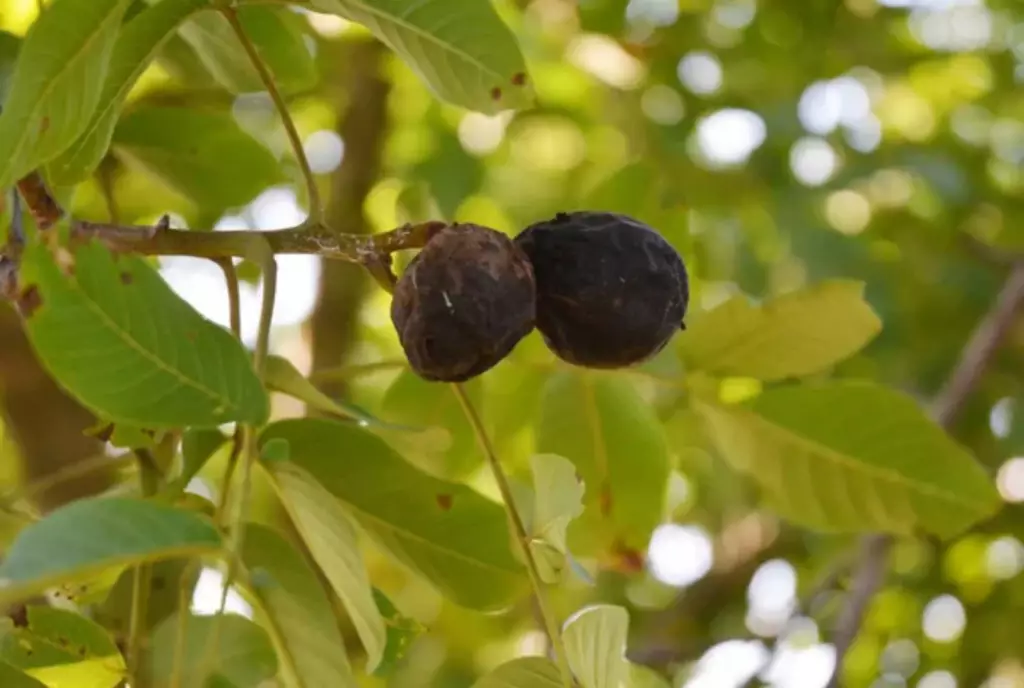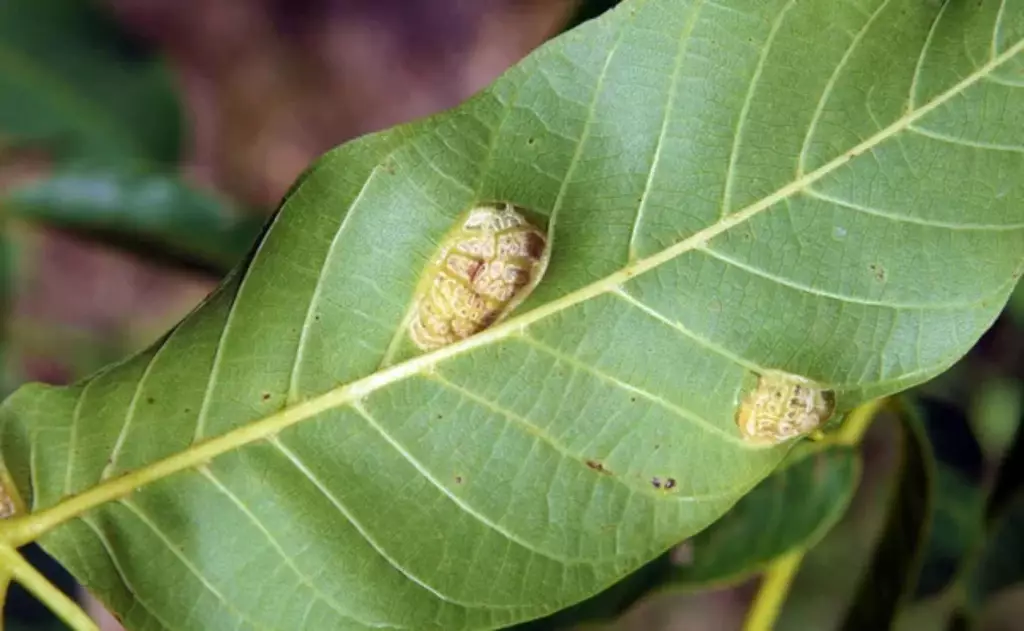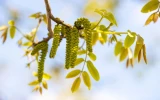Common Black Walnut Problems: 19 Diseases with Pictures
Black walnut trees are susceptible to a range of problems, including insect infestations, fungal diseases, and nutrient deficiencies. Identifying these problems early is key to preventing them from spreading and causing serious damage to your trees. In this article, we will discuss 19 common black walnut problems and diseases, so you can take proactive steps to protect your trees and keep them healthy.
Some common black walnut problems are Cankers disease, Anthracnose, Walnut blight, bunch disease, Phytophthora & Armillaria root rot, Verticillium wilt, leaf spot, leaf blotch, Botryosphaeria canker, crown gall, witches' broom, rust, mildew, wood decay & walnut caterpillar, husk fly, aphids, & twig beetle.
Walnut blight is a plant disease caused by a bacterium that leads to symptoms such as wilting, browning, and ultimately the death of the flowers and fruit. Let's take a closer look at how each problem, whether pests or diseases, affects black walnut trees.
Being aware of common black walnut problems is crucial, as it will equip you to effectively manage and mitigate these challenges, ensuring the health and productivity of your orchard, when starting your walnut farm from scratch.
Summary
- The black walnut tree is susceptible to a wide range of diseases and pests, including fungal infections, bacterial pathogens, and insect infestations, which can lead to various symptoms such as wilting, leaf discoloration, dieback of branches, and reduced nut production.
- Some of the most serious problems affecting black walnut trees, such as Thousand Cankers Disease and Phytophthora Root Rot, can ultimately lead to the death of the tree if left untreated, highlighting the importance of early detection and effective management strategies.
- Certain pathogens, such as Agrobacterium tumefaciens, are associated with multiple problems, causing both Walnut Bunch Disease and Walnut Crown Gall, indicating the potential for complex interactions between pathogens and the tree's immune response.

On this page:
Common Black Walnut Problems
The table below summarizes 19 of the most common black walnut problems and their causative agents, as well as their manifestations or effects on your trees:
| Common Black Walnut Problem | Causative Agent | Manifestations in Black Walnuts |
|---|---|---|
| Thousand Cankers Disease | Geosmithia morbida | Small cankers on branches and trunk, wilting leaves, dieback of branches, eventual tree death |
| Walnut Anthracnose | Gnomonia leptostyla | Brown spots on leaves, defoliation, reduced nut production, cankers on twigs and branches |
| Walnut Blight | Xanthomonas arboricola pv. juglandis | Dark lesions on leaves, leaf drop, twig dieback, reduced nut yield, cankers on shoots and fruit husks |
| Walnut Bunch Disease | Agrobacterium tumefaciens | Abnormal growth of shoots, witches' broom, reduced nut production, stunted tree growth |
| Walnut Caterpillar | Datana integerrima | Defoliation, feeding damage on leaves, silk tents, reduced nut production, weakened tree health |
| Walnut Husk Fly | Rhagoletis completa | Larvae in developing nuts, premature nut drop, tunneling in husks, reduced nut quality and yield |
| Walnut Twig Beetle | Pityophthorus juglandis | Galleries under bark, wilting foliage, dieback of branches, reduced nut production, eventual tree death |
| Phytophthora Root Rot | Phytophthora cinnamomi | Wilting, yellowing leaves, reduced growth, root and crown rot, eventual tree death |
| Armillaria Root Rot | Armillaria mellea | Yellowing, wilting, and dieback of leaves and branches; cankers on the trunk and roots |
| Verticillium Wilt | Verticillium spp. | Wilting, yellowing, and browning of leaves; stunted growth |
| Walnut Aphids | Pterocallis juglandis | Curling and distorted leaves |
| Walnut Zonate Leaf Spot | Cristulariella moricola | Circular, zonate spots on leaves; premature defoliation |
| Walnut Brown Blotch | Gnomoniopsis smithogilvyi | Brown, irregularly shaped lesions on leaves and nuts |
| Walnut Botryosphaeria Canker | Botryosphaeria spp. | Sunken cankers on branches and trunk; dieback of shoots |
| Walnut Crown Gall | Agrobacterium tumefaciens | Galls on roots and lower trunk; stunted growth |
| Walnut Witches' Broom | Phytoplasma | Abnormal, clustered growth of shoots; reduced vigor |
| Walnut Leaf Rust | Puccinia juglandis | Yellow-orange pustules on leaves; premature defoliation |
| Walnut Powdery Mildew | Erysiphe spp. | White, powdery growth on leaves and nuts |
| Walnut Wood Decay | Xylaria polymorpha | Soft, spongy wood; decayed areas in trunk and branches |
Thousand cankers disease poses a serious threat to black walnuts
Causative agent: Geosmithia morbida and the walnut twig beetle (Pityophthorus juglandis)

This disease gets its name from the numerous small cankers that form under the bark of the tree, ultimately leading to the tree's decline and death.
TCD was first discovered in the western United States and has since spread to the eastern U.S. where black walnut trees are more common. The disease is of great concern because black walnut trees are economically and ecologically valuable.
Efforts are underway to manage and control TCD, including research into resistant tree varieties, insecticides to target the walnut twig beetle, and quarantines to prevent the movement of infected wood. However, the disease remains a significant threat to black walnut trees in affected areas.
Walnut anthracnose is caused by a fungus that infects the tree leaves
Causative agent: Gnomonia leptostyla

Black walnut anthracnose primarily affects black walnut trees and is characterized by the development of small, irregularly shaped brown spots on the leaves.
As the disease progresses, these spots may coalesce and cause defoliation, leading to a decline in tree health.
The fungus overwinters in infected leaf litter and releases spores in the spring, which are spread by rain and wind to infect new leaves.
The disease is more prevalent in wet and humid conditions, and it can be particularly damaging to young walnut trees. To learn how to mitigate black walnut anthracnose, you can read about pest and disease management on black walnut farms in this article.
Walnut blight infects the flowers and fruit of the tree
Causative agent: Xanthomonas arboricola pv. juglandis

Walnut blight is a plant disease that affects the flowers and fruit of walnut trees. It is caused by a bacterium called Xanthomonas arboricola pv. juglandis. This bacterium infects the tree, leading to symptoms such as wilting, browning, and ultimately the death of the flowers and fruit.
The disease can impact the overall health and productivity of walnut trees, making it a concern for walnut growers and agricultural experts.
Management strategies for walnut blight may include cultural practices, chemical control, and the use of disease-resistant walnut tree varieties. Learn more about the risks and challenges of a walnut farm in this article and get a few tips on how to counteract them.
The walnut bunch disease forms small bunched leaves at the tree's apex
Causative agent: Agrobacterium tumefaciens

Walnut bunch disease, also known as walnut bunchy top, is a plant disease caused by the bacterium Agrobacterium tumefaciens. This disease primarily affects walnut trees and can lead to significant economic losses in walnut orchards.
The characteristic symptoms of this disease include stunted growth, leaf distortion, and the formation of small, bunched leaves at the tree's apex. These symptoms can have a detrimental impact on the overall health and productivity of walnut trees.
Agrobacterium tumefaciens, the causal agent of this disease, is a soil-borne bacterium that infects the host plant through wounds in the roots or at the base of the tree.
The management of walnut bunch disease involves practices such as maintaining proper orchard hygiene, using disease-free planting material, and avoiding root damage during cultural practices that can help prevent the spread of the disease.
The walnut caterpillar feeds on the leaves of black walnut trees
Scientific name: Datana integerrima

The walnut caterpillar poses a significant problem for black walnut trees due to its feeding habits and defoliation. These caterpillars can cause extensive damage to the leaves of the trees, leading to reduced nut production and weakened overall tree health.
The caterpillars can feed voraciously on the leaves of black walnut trees, stripping them of their foliage. This defoliation can weaken the trees, making them more susceptible to other stresses such as disease and environmental factors.
Additionally, the loss of foliage can reduce the tree's ability to photosynthesize and produce energy, ultimately impacting its overall health and vigor.
Furthermore, they are known to construct silk tents in the branches of trees as they feed and develop. These silk tents can be unsightly and may also indicate the presence of a significant caterpillar population, signaling potential future damage to the tree.
Walnut husk fly lays eggs on developing black walnuts
Scientific name: Rhagoletis completa

The presence of the walnut husk fly poses a significant problem for black walnut trees and their yield. This insect species infests black walnut trees by laying eggs in the developing nuts.
Once the eggs hatch, the larvae tunnel into the husks and feed on the developing nuts. This activity leads to premature nut drop, reduced nut quality, and a decrease in overall yield.
This is a concern for commercial walnut growers as it affects the market value of the nuts. Additionally, the premature nut drop caused by the infestation can lead to a significant decrease in the overall yield of the walnut trees which impacts the economic viability of walnut orchards and can result in financial losses for growers.
Furthermore, the tunneling activity of the fly larvae within the husks can weaken the structural integrity of the nuts.
This not only affects the visual appeal of the nuts but also makes them more susceptible to secondary infections or infestations by other pests. As a result, the overall health and productivity of the black walnut trees are compromised.
The walnut twig beetle attacks the twigs of black walnut trees
Scientific name: Pityophthorus juglandis
The walnut twig beetle is a small, brown beetle that has become a significant problem for black walnut trees in North America. This beetle is a vector for the fungal pathogen Geosmithia morbida, which causes Thousand Cankers Disease (TCD) in walnut trees.
The adult beetles bore into the twigs and branches of walnut trees to create galleries where they lay their eggs. As they feed and reproduce, they introduce the fungal pathogen into the tree.
The fungus then colonizes the galleries created by the beetles, leading to the formation of numerous small cankers on the branches and trunk.
These cankers disrupt the flow of water and nutrients within the tree, ultimately leading to dieback of the branches and, in severe cases, tree mortality.
Efforts to manage this beetle include monitoring and early detection, insecticide treatments, and the removal and destruction of infested trees to prevent the spread of the disease.
Phytophthora root rot is caused by a water mold
Causative agent: Phytophthora cinnamomi
Phytophthora root rot is caused by the soil-borne oomycete pathogen Phytophthora cinnamomi, which infects the roots and the lower trunk of the tree.
The pathogen thrives in wet, poorly drained soils, making it particularly problematic for black walnut trees growing in these conditions.
Once the pathogen enters the root system, it causes rotting of the roots and disrupts the tree's ability to absorb water and nutrients.
This can lead to symptoms such as yellowing or wilting of the foliage, stunted growth, and in severe cases, tree death. Phytophthora root rot can also weaken the tree, making it more susceptible to other stressors such as drought and other diseases.
Armillaria root rot is caused by a fungus that infects the roots of the tree
Causative agent: Armillaria mellea
Armillaria root rot, also known as oak root fungus or shoestring root rot, is a common and destructive disease that affects a wide range of woody plants, including black walnut trees.
This fungal disease is caused by species of the Armillaria genus and is characterized by the formation of white mycelial fans or sheets under the bark, as well as the presence of black, shoestring-like structures (rhizomorphs) on infected roots.
Black walnuts are highly valued for their timber, nuts, and ornamental qualities, making them a significant component of many forests and landscapes.
When infected with Armillaria root rot, these trees can experience reduced growth, dieback of branches, and ultimately death, leading to economic losses and ecological impacts.
The pathogen spreads through root-to-root contact, soil, and sometimes airborne spores, making it difficult to control once established.
Additionally, the fungus is known for its ability to survive for long periods in the soil, even in the absence of a host plant, further complicating management efforts.
Furthermore, the presence of Armillaria root rot in black walnut stands can hinder the establishment and growth of new trees, as the pathogen can infect and kill young seedlings, perpetuating the cycle of disease and impacting forest regeneration.
Verticillium wilt is caused by a soil-borne fungus
Causative agent: Verticillium spp.

One of the primary symptoms of Verticillium wilt in black walnut trees is wilting, yellowing, and browning of the leaves. This occurs as the fungus infects the vascular system of the tree, restricting the flow of water and nutrients to the leaves.
As a result, the leaves begin to wilt, turn yellow, and eventually brown as they die off. This can significantly affect the overall appearance of the tree and may lead to defoliation, reducing its ability to photosynthesize and produce energy.
In addition to leaf symptoms, stunted growth is another common consequence of Verticillium wilt in black walnut trees. The restricted movement of water and nutrients throughout the tree can impede its normal growth and development.
This can be particularly problematic in young trees or newly planted saplings, as it can hinder their establishment and overall vigor.
Aphids can potentially transmit plant diseases
Scientific name: Pterocallis juglandis

Aphids can become a significant problem for black walnut trees due to their feeding habits and potential to transmit plant diseases.
These small, soft-bodied insects feed on the sap of black walnut trees, causing damage to the leaves by inducing curling and distortion. Additionally, aphids can transmit various plant diseases, further compromising the health of the trees.
The feeding activity of aphids can lead to reduced photosynthesis and overall stress on the black walnut trees, potentially impacting their growth and productivity.
Furthermore, the distortion of leaves can affect the aesthetic appeal of the trees, particularly in landscaping or ornamental settings.
One approach to address this issue is to use insecticidal soap or neem oil, which can be sprayed onto the trees to target and eliminate the aphids. These natural methods can help manage aphid populations while minimizing the impact on the environment.
Walnut zonate leaf spot causes leaves to turn yellow and brown
Causative agent: Cristulariella moricola

The walnut zonate leaf spot, caused by the fungus Cristulariella moricola, typically manifests as small, circular spots on the leaves that are zoned with different colors, giving it a distinctive appearance.
This can lead to defoliation of the black walnut tree. As the disease progresses, the spots may coalesce, causing extensive browning and death of the leaf tissue. This can weaken the tree and affect its overall health and vigor.
Walnut brown blotch is characterized by the development of brown spots on leaves
Causative agent: Gnomoniopsis smithogilvyi

Walnut brown blotch, caused by the fungus Gnomoniopsis smithogilvyi, can pose several problems for black walnut trees.
The disease is characterized by the development of brown, irregularly shaped lesions on both the leaves and nuts of the tree.
The lesions can cause premature defoliation, reducing the tree's ability to photosynthesize effectively and impacting its vigor. Additionally, affected nuts may experience reduced quality and market value.
If left unmanaged, this can spread throughout the tree and potentially to neighboring trees, especially under favorable environmental conditions.
Walnut Botryosphaeria canker infects the bark of the tree
Causative agent: Botryosphaeria spp.
Walnut Botryosphaeria canker is characterized by the development of sunken cankers on branches and the trunk, often leading to dieback of shoots.
The development of sunken cankers on the branches and trunk can weaken the structural integrity of the tree. As the disease progresses, the cankers can expand, leading to wood decay and potential breakage of affected branches.
The affected branches may fail to produce new growth, leading to a loss of foliage and a potential reduction in photosynthetic capacity, which can impact the tree's ability to produce energy and nutrients.
Walnut crown galls can reduce the growth and yield of the tree
Causative agent: Agrobacterium tumefaciens

Walnut crown galls can become a problem for black walnut trees due to the formation of abnormal growths on the roots and lower trunk caused by the bacterium Agrobacterium tumefaciens.
These galls disrupt the flow of water and nutrients within the tree, leading to reduced growth, stunted development, and decreased overall health.
Additionally, the galls can weaken the structural integrity of the tree, making it more susceptible to wind damage and breakage. In severe cases, the galls can even girdle the trunk, ultimately leading to the death of the tree.
Walnut witches' broom infects the buds and shoots of the tree
Causative agent: Phytoplasma

Walnut witches' broom is caused by a phytoplasma, which is a type of bacteria-like organism that infects the plant and disrupts its growth patterns. This leads to the characteristic abnormal growth of small, dense clusters of twigs or branches, resembling a broom.
The dense clustering of shoots can inhibit the healthy development of the tree, leading to reduced vigor. This can result in stunted growth, decreased foliage, and overall diminished health of the tree.
Additionally, the abnormal growth pattern may also affect the tree's ability to photosynthesize effectively, further impacting its growth and productivity.
Walnut leaf rust is seen by the development of rust-colored spots on the leaves
Causative agent: Puccinia juglandis

Walnut Leaf Rust, caused by the fungus Puccinia juglandis, can have a significant impact on black walnut trees. The presence of yellow-orange bumps on the leaves is a characteristic symptom of this disease.
These pustules, also known as rust pustules, contain spores that can spread the infection to other parts of the tree and to neighboring trees.
The premature defoliation can weaken the black walnut tree, affecting its overall health and vigor. When a tree loses its leaves prematurely, it can disrupt its ability to photosynthesize and store energy for the winter months.
This can lead to reduced growth, diminished nut production, and increased susceptibility to other stressors such as pests and diseases.
Walnut powdery mildew is identified by a powdery white coating on the leaves
Causative agent: Erysiphe spp.

Walnut powdery mildew is a fungal disease that manifests as a white, powdery growth on the leaves and nuts of the tree.
This white, powdery growth on the leaves can interfere with photosynthesis, which is essential for the tree's growth and overall health. Reduced photosynthetic activity can lead to decreased energy production and nutrient uptake, ultimately affecting the tree's ability to thrive.
Additionally, infected nuts may experience stunted growth, reduced yield, and compromised quality, which can have economic implications for growers and producers.

In addressing common black walnut problems in your orchard, understanding the maturation timeline of black walnut trees is crucial, as it helps you better manage these issues throughout the different stages of the trees' growth and development.
Walnut wood decay is caused by fungi attacking the heartwood of the tree
Causative agent: Xylaria polymorpha
Black walnut trees are particularly susceptible to wood decay caused by fungi, with Xylaria polymorpha, which can attack the heartwood of the tree, leading to significant damage and potential decline in the health of the tree.
When black walnut trees are affected by wood decay, it can result in reduced timber quality, making the wood less desirable for commercial use.
This can have economic implications for industries that rely on black walnut wood for manufacturing high-quality furniture, flooring, and other wood products.
As the heartwood is essential for providing structural support and transporting water and nutrients throughout the tree, fungal infestations can weaken the tree and make it more susceptible to other stressors such as pests and diseases.
Furthermore, the aesthetic appeal of black walnut trees can be diminished by wood decay, affecting their value in landscaping and forestry.


